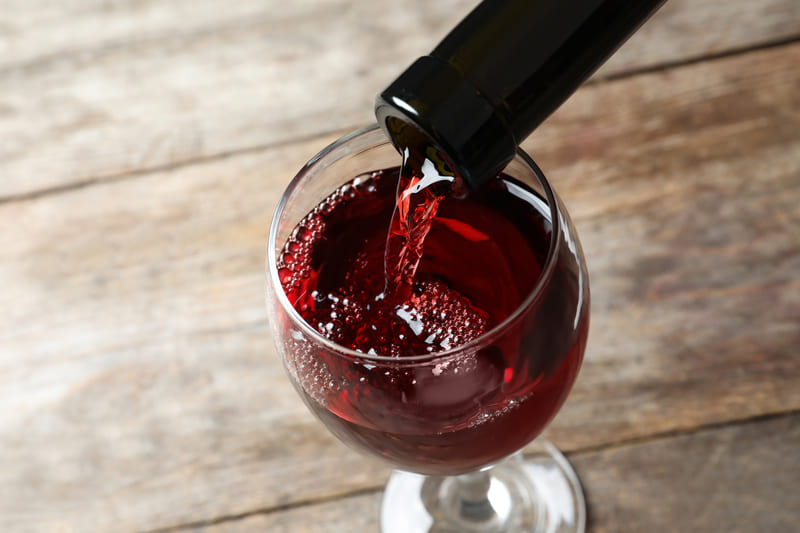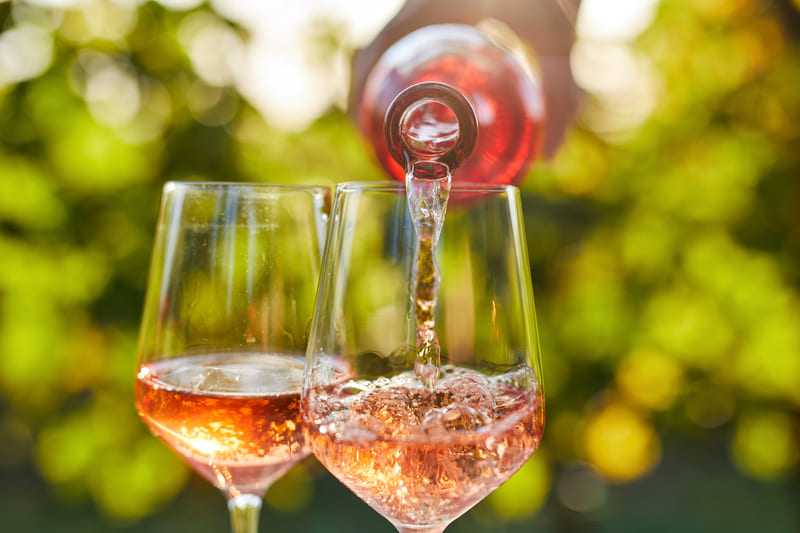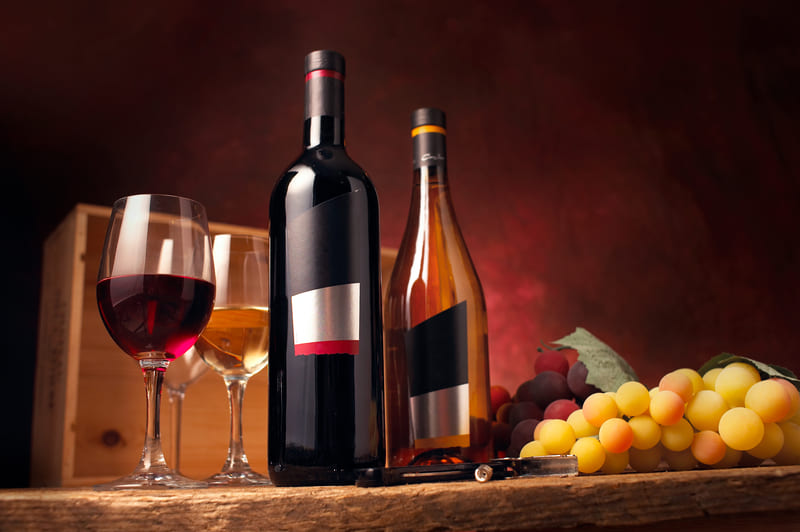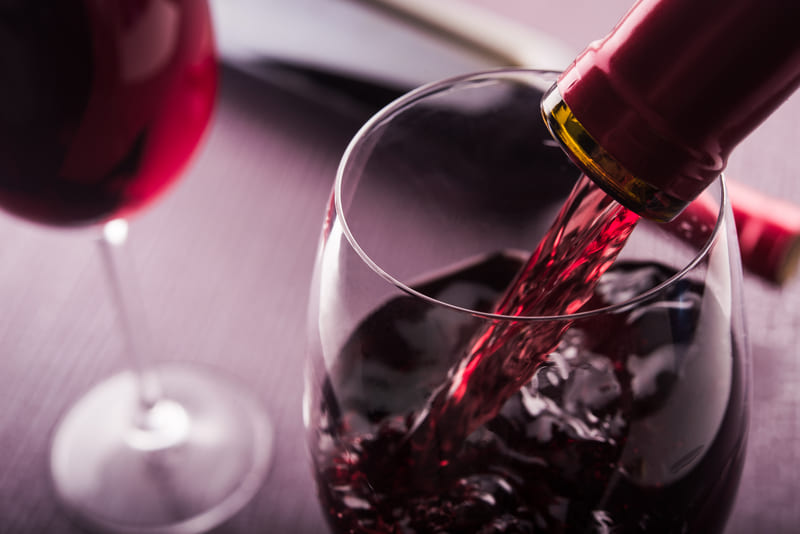It’s impossible to provide information about the specific amount of wine that will make you drunk because it can vary greatly depending on different factors.
Those factors include your body weight, gender, age, drinking experience, food intake, serving size, wine alcohol content, and other factors.
The average man can get drunk after 2-3 glasses of wine consumed in one hour, while the average woman will get drunk with 1-2 glasses of wine consumed in one hour.
Generally, it’s considered that a standard serving of wine is 5 oz (148ml), and it’s recommended that men consume two servings of wine daily while women should not consume more than one serving of wine daily.
Also check: 10 Wines with Highest Alcohol Content
However, it’s important to keep in mind that the effects of alcohol can vary from person to person and depend on various factors.
Below, I will discuss different types of wines and the factors that affect how fast you will get drunk, so let’s jump right in.
Types of Wine
There’s a wide selection of wines with different alcohol content.
As an example, red and fortified wines tend to have a higher alcohol content than white and sparkling wines, which means they may have the potential to make you drunk more quickly.
Wines can be classified in several ways, including by the type of grape used, the region, the style of wine, the method of production, the wine’s age and sweetness level, and the type of oak barrels used for aging.
Also check: What Does Red Wine Taste Like?
However, here are five broad categories of wine that are commonly recognized:
Red Wine
Red wine is made from red or black grapes, and the skin of the grapes is added to the juice during fermentation.
This process gives red wine its distinctive color and tannins, contributing to its flavor and astringency. The ABV of red wine can range from 12%-15%.
Common red wine types include Cabernet Sauvignon, Merlot, Pinot Noir, and Zinfandel.
White Wine
White wine is made from white or red grapes with the skins removed before fermentation.
White wine is typically lighter in color and body than red wine and has fewer tannins. White wine has 9%-12% ABV. Common white wine types include Chardonnay, Sauvignon Blanc, and Riesling.
Sparkling Wine
Sparkling wine is made by adding carbon dioxide to the wine during or after fermentation, which creates bubbles.
Sparkling wine can be made from any grape, either white or red. The ABV of sparkling wine can range from 10%-13%. Champagne, Prosecco, and Cava are some common sparkling wine types.
Rose Wine
Rose wine is made from red grapes with the skins removed after a short fermentation period, and it has a pink color and a lighter body than red wine.
Rose wine has 9%-12% ABV. Provence Rose and White Zinfandel are common types of rose wine.
Fortified Wine
Fortified wine has a distilled spirit, such as brandy, added to it to increase the alcohol content. Its ABV is usually higher than other types of wine and can range from 15%-22%. Port, Sherry, and Madeira are types of fortified wine.
Remember that these are general estimates, and the actual ABV of a particular wine may vary. It’s important to note that the ABV of a wine can affect its flavor and the way the drinker perceives it.
Wines with a higher ABV tend to be fuller-bodied and have a more intense flavor, while wines with a lower ABV tend to be lighter and more delicate.
Also check: How Much Champagne To Get Drunk?
Factors That Affect How Fast You Will Get Drunk
Several factors can affect how quickly you will get drunk when you consume alcohol.
Your Body Weight
Generally, the more you weigh, the more alcohol you can consume before getting drunk. This is because alcohol is distributed throughout the water in your body, and someone who weighs more has more water in their body to dilute alcohol.
Alcohol Content of the Drink
Different types of alcohol have different alcohol concentrations or alcohol by volume (ABV).
For example, beer typically has a lower ABV than hard liquor, so you may get drunk faster if you consume a shot of hard liquor rather than a glass of wine or a can of beer.
The higher the alcohol content of a drink, the faster a person will get drunk.
Rate of Consumption
The faster you drink, the quicker you will get drunk, as your body will not have enough time to metabolize the alcohol.
Amount of Alcohol You Had
The more alcohol a person drinks, the more intoxicated he will become.
Your Gender
Women usually get drunk faster than men, as they have less water in their bodies, so there is less water to dilute the alcohol.
Your Age
As you get older, your body becomes less efficient at metabolizing alcohol, so that you may get drunk faster.
Physical Activity
Engaging in physical activity before or while drinking can increase a person’s metabolism and help them metabolize alcohol more quickly, which may make them feel less intoxicated.
Food Intake
If you have eaten a meal before or while drinking, the food can help to slow the absorption of alcohol into your bloodstream.
Medications
Some medications can interact with alcohol and increase the effects of intoxication. For example, taking a sedative before or while drinking can make a person feel more intoxicated than they would otherwise.
Tolerance
People who drink alcohol regularly may have a higher tolerance for it and may not get drunk as quickly as someone who doesn’t drink as often.
Hydration
Being well-hydrated can help a person metabolize alcohol more efficiently and may make them feel less intoxicated.
Genetics
Some people may have a genetic predisposition to metabolize alcohol more quickly or slowly, which can affect their level of intoxication.
Stress or Emotional State
Stress or other negative emotions can increase the effects of alcohol and make a person feel more intoxicated.
Body Temperature
A person’s body temperature can affect how quickly they metabolize alcohol.
For example, if a person is in a hot environment or exercising, their body temperature may be higher, which can increase their metabolism and help them metabolize alcohol more quickly.
Hormonal Changes
Changes in hormone levels, such as those that occur during menstruation, can affect a person’s sensitivity to alcohol and how quickly they metabolize it.
Sleep
Lack of sleep or poor quality sleep can affect a person’s metabolism and increase their sensitivity to alcohol, which may make them feel more intoxicated.
Health Conditions
Certain health conditions, such as liver disease or pancreatitis, can affect a person’s ability to metabolize alcohol and may increase their sensitivity to it.
It’s important to remember that the effects of alcohol can vary greatly because every person is different and can be affected by a combination of the factors above.
Tips on How to Avoid Getting Drunk While Drinking Wine
The following tips can help you enjoy your wine without getting drunk, so take a look.
Know the Alcohol Content of the Wine You’re Drinking
Wines can vary in alcohol content, with some having as little as 9% ABV and others having as much as 16% ABV or more.
Knowing the alcohol content of the wine you’re drinking can help you gauge how much you can safely consume.
Choose Lower-Alcohol Wines
Wines with lower alcohol content, such as white or sparkling wine, tend to have less alcohol than red and fortified wines, which can help you avoid getting drunk.
Drink Slowly
Sipping your wine slowly can help you better gauge your level of intoxication and prevent you from getting too drunk.
Have a Glass of Water Between Glasses of Wine
Staying hydrated can help your body metabolize alcohol more efficiently, preventing you from getting too drunk.
Eat Before or While Drinking
Food in your stomach can help slow the absorption of alcohol into your bloodstream and prevent you from getting drunk too quickly.
Alternate Between Wine and Non-alcoholic Drinks
Alternating between glasses of wine and non-alcoholic beverages can help you pace yourself and prevent you from getting drunk.
Don’t Mix Different Types of Alcohol
Mixing different types of alcohol can increase the rate at which you get drunk and may lead to more severe hangovers.
Know Your Limits
It’s important to be aware of how much alcohol your body can handle and to stick to that limit.
Don’t Drink and Drive
Drinking and driving aren’t a good combination, as the consequences can be severe. If you plan on drinking, arrange for a designated driver or alternative transportation.
Can 2 Glasses of Wine Make You Drunk?
Two glasses of wine can make you drunk, depending on several factors, including your weight, gender, age, overall health, wines ABV, and other factors.
The effect of alcohol on the body is measured by the blood alcohol concentration(BAC), which is the percentage of alcohol in your blood.
The amount of alcohol in a glass of wine can vary greatly, but on average, a glass of wine contains about 12-14%alcohol by volume.
So, if you drink two glasses of wine with 12% or 14% alcohol by volume, you consume approximately 1.2-1.4 ounces of alcohol. For most adults, a BAC of 0.08%or higher is considered legally drunk.
This means that two glasses of wine can make you drunk if you’re a smaller person or if you have consumed the wine on an empty stomach.
For others, it may take more or less wine to reach this level of intoxication.
It’s important to remember that the effects of alcohol can vary greatly from person to person, and it’s always best to drink responsibly.
Does Wine Get You Drunk Easily?
Wine can get you drunk easily, but the rate at which it affects you can vary depending on a number of factors.
Some factors that can influence how quickly wine affects you include the type and amount of wine you’re drinking, your weight, age, gender, and other factors mentioned above.
In general, the higher the alcohol content of the wine and the amount you have consumed more quickly it will get you drunk.
Red wine typically has a higher alcohol content than white wine, which may cause you to become drunk more easily.
It’s also important to consider your tolerance for alcohol. If you’re more sensitive to the alcohol effects, you can become drunk more quickly than others who have a higher tolerance to alcohol.
How Much Wine Does it Take to Feel Tipsy?
The amount of wine that can make you drunk depends on some factors.
However, one or two drinks for women and two to three for men in an hour are enough to make them feel tipsy.
Still, this can vary depending on the individual because everyone’s body is different and have a different tolerance to alcohol.
Will a 750ml Bottle of Wine Get You Drunk?
Yes, a 750ml bottle of wine will get you drunk because it contains about five standard glasses of wine, and each standard glass contains approximately 0.6 oz of alcohol.
That means a 750 ml (25.4 oz) bottle of wine with an ABV of 12% contains approximately 3.04 oz alcohol.
A person who weighs about 150 pounds may feel the effects of alcohol after consuming two standard glasses of wine with 12% ABV within an hour.
However, it’s important to note that this is just a general guideline, and the way that alcohol affects an individual is influenced by a number of factors and can vary greatly.
How Much Wine to Get Drunk by Weight?
People with higher body weights, in general, can consume more wine before getting drunk because they have more water in their bodies.
This means that people with higher body weights can dilute the alcohol in their bodies more effectively.
Here are some rough estimates of the amount of wine a person might need to consume to get drunk based on their body weight and the alcohol content of the wine drunk in one hour. The glasses of wine contain 5 oz, and the wine has 12% ABV.
| Weight (lbs) | Weight (kg) | Number of glasses | BAC (%) |
| 100 | 45.4 | 3 | 0.08 |
| 120 | 54.4 | 3 | 0.08 |
| 140 | 63.5 | 4 | 0.08 |
| 160 | 72.6 | 4 | 0.08 |
| 180 | 81.6 | 5 | 0.08 |
| 200 | 90.7 | 6 | 0.08 |
| 220 | 99.8 | 6 | 0.08 |
A person’s blood alcohol concentration (BAC) measures the amount of alcohol in their bloodstream. Driving with a BAC of 0.08% or higher in the United States is illegal.
Note that these are just estimates and can vary based on the individual and the specific circumstances.
How Many Shots of Wine to Get Drunk?
The number of shots of wine that can make you drunk depends on various factors.
But in general, an average man can get drunk after two to three glasses of wine consumed in one hour, while an average woman will get drunk with 1-2 glasses of wine consumed in one hour.
Can Red Wine Get You Drunk?
Yes, red wine can get you drunk if you drink enough of it.
Red and fortified wines tend to have a higher alcohol content than white and sparkling wines, which means they may have the potential to make you drunk more quickly.
The amount of alcohol in red wine can affect your level of intoxication. The alcohol content of red wine can vary, but it’s usually around 12-15%.
So if you drink a standard glass of red wine, about 5 oz, you consume about 0.6-0.75oz of pure alcohol.
Drinking more than one standard serving (5 oz) of red wine per hour can get you drunk because your liver can’t metabolize more than one standard serving of red wine per hour.
How Long Does Wine Take to Kick in?
Wine same, like other types of alcohol, begins to be absorbed into the bloodstream as soon as it’s consumed. The rate at which this occurs can vary from person to person.
On average, it takes about 30-60 minutes for the effects of wine to be noticeable. However, some people may feel the effects of wine more quickly or slowly depending on several factors mentioned above.
Can You Feel Tipsy After One Glass of Wine?
You can feel tipsy after one glass of wine. The effects of alcohol depend on a number of factors, including the amount of wine consumed, its alcohol content, your weight, age, gender, and others.
Final Thoughts
Drinking wine in moderation can be a part of a healthy lifestyle for some people.
Generally, moderate alcohol drinking is defined as one beverage daily for women and two drinks for men.
While drinking large amounts of wine can have serious health consequences like liver damage, pancreatitis, high blood pressure, and increased risk of certain cancers.
Therefore, drink responsibly and never drink and drive.
If you have other drinking tips, comment below, and let’s chat about alcohol.





